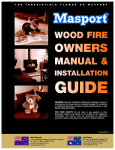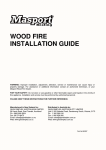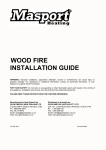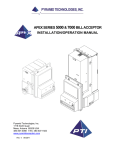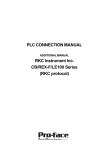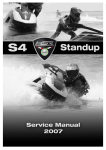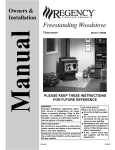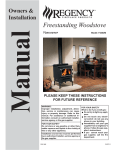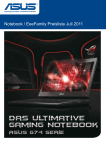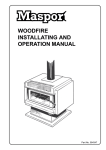Download Country Hearth 2000 Operating instructions
Transcript
THE INSTALLATION AND OPERATING INSTRUCTIONS IN THIS MANUAL APPLY TO THE FOLLOWING WOODFIRES:Free standing models:- MASPORT TALISMAN MASPORT HORIZON MASPORT LE 2000, 2000/S, 2000/W MASPORT LE 3000, 3000/S, 3000/W (Series 2 models) MASPORT LE 5000, 5000/S, 5000/W (Series 2 models) MASPORT LE 7000, 7000/S, 7000/W (Series 2 models) MASPORT LE 7000 MASPORT COLORADO (Series 2) MASPORT PANORAMA (Series 2) and (Series 3) MASPORT GRANDVIEW MASPORT TORONTO In-built models:- MASPORT LE 3000 PROVINCIAL (Series 2) MASPORT LE 3000/S PROVINCIAL (Series 2) MASPORT LE 3000/W PROVINCIAL (Series 2) MASPORT LE 3000 PROVINCIAL (Clean Air Zone) MASPORT LE 7000 PROVINCIAL (Australia) Note: Models /S have been emission tested for N.Z. without water boosters. Models /W have been emission tested for N.Z. with water boosters. CONTENTS OF LOOSE PARTS BAG (Note: You may not need all these parts for your installation) Part No. 501682 Quantity Description 10 M6 Hexagon Nut 501703 501815 501959 4 4 6 M6 Flat Washer M6 x 35mm Hex. Set Screw M6 x 12mm Hex. Set Screw 503005 4 503259 4 503388 503459 2 2 593076 1 Self Threading Screw — 12mm long, zinc plated finish Self Threading Screw — 12mm long, black finish ‘C’ Nut (Spire # SNU 0537) Self Threading Screw — 25mm long Installing & Operating Manual 986413 2 ‘L’ Bracket 6mm 12mm Where Used 4 — Pedestal front to pedestal sides 4 — Firebox to pedestal 2 — ‘L’ Brackets to pedestal 4 — Firebox to pedestal 4 — Firebox to pedestal 4 — Pedestal front to pedestal sides 2 — ‘L’ Brackets to pedestal 4 — Heat shield to top of pedestal 4 — Pedestal rear panel to pedestal 2 — Seismic restraint bar to pedestal 2 — Seismic restraint bar to pedestal 2 — Sides or rear of pedestal 25mm 35mm CONTENTS INTRODUCTION............................................................................2 FREE-STANDING MODELS — INSTALLATION UNPACKING ..................................................................................3 ASSEMBLY ....................................................................................3 POSITIONING ............................................................................4, 5 HEARTH (FLOOR PROTECTOR) REQUIREMENTS...................6 CORNER HEARTHS (FLOOR PROTECTORS).............................7 HEARTH (FLOOR PROTECTOR) CONSTRUCTION...................8 INSTALLING THE FLUE...............................................................8 FIXING IN POSITION....................................................................8 FINAL ASSEMBLY ........................................................................9 INSTALLING A WATER HEATING BOOSTER .........................10 IN-BUILT MODELS — INSTALLATION UNPACKING ................................................................................11 INSTALLATION REQUIREMENTS ............................................11 FIREPLACE ..................................................................................11 MANTEL-SHELF..........................................................................11 HEARTH (FLOOR PROTECTOR)............................................... 12 INSTALLING THE FIREBOX AND FLUE ..................................12 FITTING INTERNAL PARTS.......................................................12 FASCIA .........................................................................................12 INSTALLING A WATER HEATING BOOSTER .........................13 OPERATING INSTRUCTIONS — ALL MODELS BASIC INFORMATION................................................................14 LIGHTING UP ........................................................................14, 15 OPERATING HINTS ....................................................................15 SAFETY ........................................................................................16 MAINTENANCE...........................................................................17 BEFORE EACH HEATING SEASON...........................................18 THIS BOOK CONTAINS IMPORTANT INFORMATION. PLEASE KEEP IT IN A SAFE PLACE FOR FUTURE REFERENCE. 1 INTRODUCTION In the interests of your safety, most building regulatory Authorities in Australia and New Zealand require any woodfire installation to comply with the relevant National Standard. They may also have local requirements in addition to those in the Standard so you should approach your local Building Authority before commencing installation to establish whether you will require a Permit and whether you will need to meet extra requirements. All MASPORT Woodfires have been tested to ensure that they will meet the appropriate safety Standard requirements if the instructions in this book are followed. Woodfire models covered by this manual have been tested to demonstrate compliance with current emission Standards in Australia and New Zealand. WE RECOMMEND THAT THE INSTALLATION OF YOUR MASPORT WOODFIRE BE CARRIED OUT BY A QUALIFIED SPECIALIST INSTALLER. IF ANY ELECTRICAL WORK IS REQUIRED, IT MUST BE CARRIED OUT BY A LICENSED ELECTRICIAN PLEASE ENSURE THAT ONLY COMPONENTS APPROVED BY MASPORT ARE USED FOR THE INSTALLATION, as substitutes may adversely affect performance and might nullify compliance with the requirements of your Standard. WARNING: THE APPLIANCE AND FLUE MUST BE INSTALLED IN ACCORDANCE WITH CURRENT INSTALLATION STANDARDS AND THE APPROPRIATE REQUIREMENTS OF THE RELEVANT BUILDING CODE OR CODES. CAUTION: MIXING OF APPLIANCE OR FLUE SYSTEM COMPONENTS FROM DIFFERENT SOURCES OR MODIFYING THE DIMENSIONAL SPECIFICATION OF COMPONENTS MAY RESULT IN HAZARDOUS CONDITIONS. WHERE SUCH ACTION IS CONSIDERED, THE MANUFACTURER SHOULD BE CONSULTED IN THE FIRST INSTANCE. CAUTION: CRACKED AND BROKEN COMPONENTS, e.g. GLASS PANELS OR CERAMIC TILES, MAY RENDER THE INSTALLATION UNSAFE. Additionally, for woodfires using water heating devices:WARNING: DO NOT CONNECT TO AN UNVENTED HOT WATER SYSTEM. INSTALL IN ACCORDANCE WITH AS 3500.4 OR NZS 4603 AND THE APPROPRIATE REQUIREMENTS OF THE RELEVANT BUILDING CODE OR CODES. Some areas in New Zealand and Australia have special emission regulations and MASPORT woodfires are approved for use in those areas. Approval has been given provided that no modifications are made to the appliance. In New Zealand areas covered by emission regulations:(I) Any water heating device must be factory fitted or be a Masport accessory retro-fitted strictly in accordance with the instructions on page 10. (II) Coal must not be used as a fuel. (III) Wood fuel must have a moisture content of less than 25% 2 FREE-STANDING MODELS (See page 11 for in-built models) UNPACKING After removal of the shipping carton, open the door and take out all loose parts except the polystyrene packers above the top baffle. Do NOT discard the top baffle. You may find it more convenient to lift the door from its hinges at this stage. Remove and discard the four bolts holding the woodfire to the shipping pallet. Remove the woodfire from the pallet, lifting only from the lower edge of each side. DO NOT LIFT BY THE LOWER FRONT PANEL OR THE REAR PANEL. ASSEMBLY OF FREE-STANDING MODELS The table inside the front cover will help you identify the various fastenings. First assemble the pedestal. Secure the two pedestal sides to the front, using four M6x12 set screws and taking care that the bottom flanges of the side panels align with the bottom flange of the front panel. The top flange of the front panel will be above the top flanges of the sides. Fit the slotted pedestal rear panel using the four black 12mm long self threading screws (sharp points). If your woodfire will have a fan, this will be fitted LATER in place of the pedestal rear panel. Using the four zinc plated 12mm long self threading screws (blunt points), screw the bottom heat shield to the top of the pedestal assembly with the turned up ends of the heat shield facing away from the pedestal. Check that the pedestal surround (foot) and trim (if any) will fit snugly around the assembled pedestal before tightening all assembly screws fully. Roll the woodfire carefully onto its back, using the flattened carton to protect the floor. Taking care that the slotted pedestal rear panel will be at the rear, attach the pedestal to the firebox using the four M6x 35 set screws, four M6 flat washers and four M6 Hexagon nuts. Place the washers on the set screws and pass the screws from inside the firebox through the holes in the pedestal. The nuts will be inside the pedestal. Check the alignment of the pedestal before tightening the nuts firmly. Roll your woodfire carefully back into the upright position. If you are installing a fan, this can now be fitted at the rear of the pedestal in place of the pedestal rear panel. 3 POSITIONING YOUR FREE-STANDING WOODFIRE Free-standing woodfires must not be installed in a fireplace or alcove, or under a ceiling of less than normal height. No wall or other immovable object may be closer to the front of the woodfire than one metre. If a water heating accessory is to be fitted, a further positioning restraint is the need to be close to your hot water storage cylinder (See page 10). Finalise the installation position for your woodfire only after considering the necessary stove to heat sensitive wall distances (See Tables below) and checking the practicability of installing the flue system through the ceiling and roof. Heat resistant walls covered with heat sensitive surface treatments (e.g. wallpaper or heat sensitive paints) should be regarded as heat sensitive walls. The flue shielding and the 25mm clearance gap around it above the ceiling will occupy a diameter of 300mm (Grandview, Colorado and Toronto 325mm), and this must be available without the removal of structural beams. Flue installations other than strictly vertical ones are possible. See current Australian and New Zealand Standards for information on flues passing through walls and eaves. Detailed dimensional requirements for the flue installation are included with every MASPORT approved flue system. NEW ZEALAND — MINIMUM DISTANCES TO HEAT SENSITIVE WALLS (mm) g Model Flue Heat Deflector A B C D E F R§ Talisman, Horizon LE 2000 LE 3000 Series 2 LE 5000 Series 2 LE 7000 Series 2 Colorado ¶ Series 2 Toronto YES - 1200 mm* NO YES - 1200 mm* NO YES - 1200 mm* NO YES - 1200 mm* NO YES - 900 mm* NO YES - 900mm* NO YES - 1200 mm* NO YES - 900 mm* NO 50 300 50 300 50 300 100 505 125 475 125 475 50 300 200 450 300 300 245 270 245 270 325 420 400 400 400 400 345 345 350 350 220 470 275 525 275 525 295 700 320 670 320 670 275 525 395 645 578 578 575 600 575 600 655 750 730 730 730 730 675 675 730 730 50 150 25 225 25 225 50 325 50 300 50 300 50 250 50 250 355 455 380 580 380 580 425 700 425 675 425 675 380 580 458 658 500 645 540 820 540 820 600 990 600 955 600 955 540 820 650 930 Panorama Series 2 & 3 Grandview * All Flue Heat Deflectors Polished Stainless Steel with top Heat Dispersal Cap. ¶ Measurements to cabinet, not top panel. § Valid only when the room walls are accurately at 90° to each other. 4 g Note: Clearances are for fire hazard only. For durability of finishes or surfaces you should contact the relevant manufacturer for their specification. MASPORT accepts no responsibility for the deterioration of surfaces or finishes. AUSTRALIA MINIMUM DISTANCES TO HEAT SENSITIVE WALLS (mm) g WITH THE APPROPRIATE FLUE HEAT SHIELD Model A B C D E F R§ Talisman Horizon LE 2000 LE 3000 Series 2 LE 5000 Series 2 LE 7000 Colorado Series 2 ¶ Toronto Panorama Series 2 & 3 Grandview 150* 150* 125 150† 150† 125 125 125 150† 150 350 350 325 325 325 300 350 350 350 350 320* 320* 295 375† 375† 320 320 320 375† 345 628 628 603 655 655 630 680 680 680 730 100 100 100 125 125 100 100 100 125 100 405 405 405 480 480 475 475 475 455 508 575 575 575 680 680 675 675 675 645 720 * May be reduced by 25mm when using the Acorn flue shielding option. † May be reduced by 25mm when using Acorn or Woodland flue shielding options. ¶ Measurements to cabinet, not top panel. § Valid only when the room walls are accurately at 90° to each other. RECOMMENDED 150mm FLUE OPTIONS:- (All except Colorado, Toronto and Grandview) Acorn Metal - Special Insulated Flue Kit with 900mm 120˚ polished reflector. Benja Pty Ltd - Benja Mk II with 900mm decorative heat shield with 120˚ solid back. Floate Metal - Flomet Super Single with full length decorative heat shield with 120˚ solid back. Shamic Sheetmetal - Model 1A with full length decorative heat shield with 180˚ solid back. (Not tested on Panorama) Statewide Heating - Model M1 with 900mm enamelled flue shield. Woodland Fireplaces - Woodland Double Flue System with flat ceiling plate and 900mm 180˚ stainless steel heat shield. For LE3000 Series 2, LE 5000 Series 2 and Panorama Series 2 only. RECOMMENDED 178mm (7”) FLUE OPTIONS:- (Colorado and Toronto only) Acorn Metal - Special Insulated Flue Kit with 900mm long half round enamelled mild steel (or polished stainless steel) flue shield. Floate Metal - Flomet 7” Super Single Flue System with full length perforated decorative heat shield with 120˚ solid back. The ceiling plate has a 200mm diameter solid metal collar extending down 150mm surrounding the decorative shield. RECOMMENDED 178mm (7”) FLUE OPTIONS:- (Grandview only) Acorn Metal - Special Insulated Flue Kit with 900mm long half-round polished stainless steel flue shield. Floate Metal - Flomet Super Single flue system with full length perforated decorative heat shield with 120˚ solid back. The ceiling plate has a 200mm diameter collar extending down 100mm surrounding the decorative shield. Statewide Heating - Standard 7” Flue Kit with 900mm long half round polished stainless steel flue shield. 5 HEARTH (Floor Protector) REQUIREMENTS — FREE-STANDING MODELS Unless your woodfire will be standing on an un-covered fireproof floor which extends at least as far as the minimum hearth areas shown below, it will be necessary to provide a hearth for floor protection. See page 8 for construction details. Where the minimum requirements bring the edge of the hearth nearly to a wall, it is better to extend the hearth to meet the wall. AUSTRALIA W B C D G H J K S# Talisman, Horizon, LE 2000 875 735 300 160 170 435 555 0 885 LE 3000 & LE5000 Series 2 935 840 350 138 225 490 660 0 990 Ditto with Acorn/Woodland Flue Shield 935 840 350 138 225 490 660 0 965 LE 7000 875 840 300 108 195 540 660 0 965 Colorado Series 2 & Toronto 965 940 300 153 195 540 660¶ 100 965 Panorama Series 2 & 3 940 915 350 140 225 565 660 0 1065 Ditto with Acorn/Woodland Flue Shield 940 915 350 140 225 565 660 0 1040 Grandview & Series 2 965 1010 300 103 195 610 760 100 1060 H J K © Ash Hearth © Insul. Hearth Fl. Defl No Fl Defl S# NEW ZEALAND W B C D Talis., Horiz., LE 2000 875 635t 200t 160 170 435 555 0 3 3 685t 935t LE 3000 Series 2 935 910* 420* 138 225 490 660 0 7 3 960* 1210* LE 5000 Series 2 935 690t 200t 138 225 490 660 0 3 3 740t 990t G LE 7000 Series 2 875 740t 200t 108 195 540 660 0 3 3 840t 1245t Colorado Series 2 965 740t 200t 153 195 540 660¶ 0 3 3 865t 1215t Toronto 965 740t 200t 153 195 540 660 0 3 3 865t 1215t Panorama Series 2 935 975* 410* 138 225 565 660 0 7 3 1025* 1275* Grandview 965 1255* 520* 103 195 610 760 125 7 3 1330* 1580* * Increase by 80 mm if the hearth top is not at least 50 mm above the floor. © See page 8 for minimum constructional requirements. t For practical purposes we recommend increasing these sizes by 100mm. ¶ Measured to cabinet, not top panel. # Valid only when the fire is exactly at its minimum allowable wall clearance. 6 CORNER HEARTHS (Floor Protectors) While the information in the previous section details the MINIMUM size of hearth necessary to comply with the Safety Standards, it may often be desirable to use a somewhat larger area of hearth for æsthetic reasons. A particular example is when the woodfire is installed diagonally in a corner. A neater appearance will result if the hearth is carried right into the corner and is shaped as shown below. The chart facilitates calculation of the MINIMUM dimensions required for hearths of this shape. Minimum allowable values for dimension ‘E’ are given in the tables on pages 4 and 5. AUSTRALIA MINIMUM DIMENSIONS — mm See pages 6, 8 for construction. Talisman, Horizon LE 2000 NEW ZEALAND X Y X Y With Shelf — — 880 425t Without Shelf 880 560 — — 980 605 1035 650* LE 3000 Series 2 LE 5000 Series 2 With Shelf 980 605 950 430t Without Shelf 980 605 — — LE 7000 Series 2 With Shelf — — 1000 520t LE 7000 Without Shelf 1000 660 — — Colorado Series 2 1025 625 1015 500t Toronto 1025 625 1015 500t Panorama Series 2 & 3 980 655 1050 675* Grandview 1100 725 1250 890* Your measurement ‘E’ must be added ‘X’ and ‘Y’ to find the appropriate minimum overall hearth dimensions. See page 4 or 5 for minimum values of ‘E’. t Increase ‘Y’ by 140mm for our recommended hearth extension. * Increase ‘Y’ by 120mm if the hearth top is not at least 50mm above the floor. 7 HEARTH (Floor Protector) CONSTRUCTION In Australia the minimum hearth construction requirement is a sheet of 6mm fibre cement board. It is usually fastened directly to the floor. In New Zealand, only the LE 3000 Series 2, the Panorama and the Grandview models require an insulating hearth. All other current models may be installed on an ash hearth. Naturally, all models may be installed on insulating hearths if desired. The necessary minimum construction details for ash and insulating hearths are shown below, and such constructions are suitable for solid timber or particle board floors. Constructions not suitable as insulating hearths are bricks or concrete in contact with the flooring material. If, however, the floor is concrete and no timber is in contact with its lower surface in the area where the hearth would normally be, a hearth is not required. If tiles or pieces of slate etc. are required for decorative purposes, they may be glued directly to the concrete floor. In all cases, in both countries, the hearth must extend right under the woodfire and a durable top surface will be needed to resist damage from heat or dropped embers. Obvious surface materials are slate, bricks and ceramic tiles. Gaps in the top surfacing material must be grouted to prevent the penetration of embers. A trim moulding will provide a neat edge finish. INSTALLING THE FLUE You MUST use a flue system which complies with the current Australian or New Zealand Standard as appropriate. In Australia, only flue systems tested with your particular model are approved for use. The flues and flue heat shields tested in Australia at the time of printing are detailed under the table on page 4. Flue heat shielding must be fitted unless all heat sensitive material is at least 600mm away from the flue surface. In New Zealand we recommend the use of genuine Masport flue kits. The flue MUST be installed in accordance with the detailed instructions accompanying it. Grandview, Toronto and Colorado ceiling plates should be 450mm square. A flue heat deflector, as detailed on page 4, may be fitted at the back of the flue (directly above the stove) to achieve the reduced wall clearances shown in the table. The Masport flue heat deflector (Part No 551481) is recommended for 150mm flues. FIXING THE WOODFIRE IN POSITION Once the flue shielding system has been installed through the ceiling and roof, the woodfire can be placed in its approximate position on the hearth, and the flue pipes installed. Finally adjust the stove position making sure the flue is vertical and that the necessary minimum woodfire-to-wall distances are being achieved. New Zealand Standards require that the woodfire and hearth be secured to prevent shifting in the event of an earthquake. This is best done by fastening the woodfire right through the hearth to the floor, using two screws not less than 12 gauge, or the equivalent size of coach bolts or toggle fasteners. Anchor the appliance through the holes in the seismic restraint bracket or in the two angle brackets supplied. The angle brackets attach at each side of the pedestal (except for the LE 2000, where they attach at the rear). The pedestal can be fastened to the seismic restraint bracket either before or after fitting the anchor screws. The small centreline hole in the bracket will help in pre-positioning it. 8 FINAL ASSEMBLY Before using the woodfire, the internal firebox components must be placed in their correct positions. No force should be required to fit them, and they can be removed, if desired, for flue cleaning. However, they MUST be in place, and in good condition, before lighting the fire. All Masport models are supplied with either fire-bricks or insulating board to line the firebox. The LE 2000 has insulating board already fixed in position at the factory. In the other models, two bricks or boards are to be fitted across the back of the firebox wall, and the others will fit against the end walls. Each brick or board is fitted in the same way. Angle it into position with its top corner behind the upper retaining lug, then swing it until it is parallel to the wall with its bottom corner behind the lower retaining lug. Lower the brick or board into position. In some models there are two or boards at each end. Fit the metal retaining channel over the top edges of these bricks to hold them in line. The wider leg of the channel goes next to the firebox wall. Carefully remove the polystyrene packing above the firebox top baffle, remembering that the baffle can be broken by rough handling. Make sure that the baffle is correctly placed on top of the supporting shelves at each side of the firebox, and that it is back far enough for the two front corners to drop behind the retaining ribs on top of the shelves. On some models, a metal reinforcing channel is provided for the baffle. Fit this along the edge of the baffle nearest the door. In cases where a pedestal foot is to be fitted, simply fit the trim into the foot and slide the assembly onto the pedestal, keeping the foot in contact with the hearth all the time to avoid marking the finish on the sides of the pedestal. Finally, refit the door, if necessary, and spread the sand provided evenly over the bottom of the firebox before lighting the first fire. 9 INSTALLING A WATER HEATING BOOSTER Water heating booster tubes can be fitted to woodfires sold in New Zealand. Fitting a water booster tube converts an /S model into a /W type. If a tube is retro-fitted, in some cases the air metering plate must be changed to ensure that emission requirements are still met. In addition, the LE 3000 and LE 5000 in the ‘Christchurch’ clean air zone will require a special secondary air tube (see table below). The air metering plate is fitted directly behind the sliding plate that controls the stove heat output, and it can be reached by removing the air control knob (remove the screw underneath), and lifting off the air grille. Water booster tube holes are provided and plugged in the back wall of the free-standing firebox and the side walls of the in-built model. All plumbing work must meet the requirements of NZS 4603 unless local building regulations dictate otherwise. Pipe connections are 1” BSP and the pipe positions are illustrated below. Special piping methods must be followed to ensure effective circulation, and the hot water cylinder will need to have an internal riser pipe to two thirds of the cylinder height to discourage unwanted water circulation when the woodfire is not burning. This internal riser pipe must be connected to the return pipe from the woodfire. For effective circulation, the pipes from the woodfire should rise at the rate of one in five toward the storage cylinder, and ideally the cylinder should be within three metres of the woodfire. Detailed piping instructions are included in the kit, but two safety requirements deserve special mention. THERE MUST BE NO NON-RETURN OR SHUT-OFF VALVES IN THE PIPES BETWEEN THE WOODFIRE AND THE STORAGE CYLINDER. A WOODFIRE FITTED WITH A WATER HEATING BOOSTER MUST NOT BE FIRED UNLESS IT IS CONNECTED TO A VENTED STORAGE CYLINDER FILLED WITH WATER FREE TO CIRCULATE. PART NUMBERS OF COMPONENTS REQUIRED FOR WATER BOOSTER CONVERSIONS IN CHRISTCHURCH AND CANTERBURY CLEAN AIR ZONES MODEL CONVERSION KIT No. WATER TUBE No. METERING PLATE No. SECONDARY AIR TUBE No. LE 3000 / 5000 Series 2 994019 586044 986178 994010 LE 3000 PROVINCIAL Series 2 995095 586593 995024 No Change Panorama Series 2 994020 586044 No Change No Change Water Pipe Connection Positions 10 IN-BUILT MODELS (See page 3 for free-standing models) All current LE Provincial models (Australian and New Zealand), can be fitted with threespeed air circulating fans. (Fans are not permitted in Provincial fires installed in the Clean Air Zones of Christchurch and Canterbury). These are mounted inside the ash shelf which protrudes below the firebox door. Fascia extending kits are available for the LE 3000 Provincial models to extend the fascia size from 650 high by 810 wide to 700 high by 900 wide to suit larger than normal fireplace openings. [Part No 986580 (black), 986585 (coffee)]. An optional mantel-shelf with a 38mm higher rear up-stand is available for the LE 7000 Provincial.[Part No 986765 (black)]. UNPACKING After removal of the shipping carton from the firebox, take out all loose parts. Note that the firebox door is shipped with the fascia. In the case of the LE 7000 Provincial, the ash shelf and fan are also shipped with the fascia. Keeping the fire upright, release it from the shipping pallet by unscrewing the shipping bolts. INSTALLATION REQUIREMENTS Please read the INTRODUCTION on page 2, as this applies also to in-built models. FIREPLACE For a safe installation the following matters must be attended to. • The fireplace and chimney must be thoroughly cleaned and checked for soundness. • The chimney must not connect to a second fireplace. • The joint between the chimney face and the fireplace surround must be checked and sealed to prevent leakage if necessary. • The fireplace recess must have a non-metallic heat resistant surround extending at least 455mm (N.Z.), 480mm (Aust.), or 540mm (for the LE 7000) each side of the recess centreline and up to at least 810mm above the base of the fireplace recess. • In New Zealand, the fireplace and chimney must comply with all the relevant Building Codes, except that the specified separation between the outside of the chimney and timber construction need not be provided. Timber may touch the outside of any part of the chimney. • A flue pipe must be fitted right up the chimney, and the space between the flue pipe and chimney must be ventilated at the top. In Australia the area of this vent must be not less than 10,000mm2, while in New Zealand it must be not less than 13,000mm2. The vent must be fitted with means to prevent significant ingress of water and debris. The flue must be free to move up and down at the top as it expands and contracts with temperature changes. This movement can be about 25mm. MANTEL-SHELF SHIELDING The need to shield a heat sensitive mantel-shelf depends on its distance above the woodfire, and how far it projects forward from the face of the masonry fireplace surround. Heights shown below are measured from the undersurface of the shelf to the bottom of the fireplace recess. In Australia, all shelves less than 1075mm high require shielding. In New Zealand, all shelves less than 1075mm high require shielding unless they project less than 75mm and are at least 955mm high. Where shielding is needed we recommend a sheet metal shield fixed 20mm below the undersurface of the shelf. It must shield the entire depth of the under-surface of the shelf, and the 20mm space must be open at the ends and front to allow air to circulate freely. 11 HEARTH (FLOOR PROTECTOR) LE 3000 Provincial hearths should be at least 900mm wide, and LE 7000 Provincial hearths must be at least 1080 wide. MINIMUM HEARTH EXTENSIONS, measured from the face of the masonry surround:AUSTRALIA — 375mm for the LE 3000 Provincial, and 430mm for the LE 7000 Provincial. ( Both regardless of hearth height). NEW ZEALAND — For LE 3000/S and /W Provincials:Hearth Elevation 60 or more 50 mm 25 mm Zero Min. Hearth extension 300 mm 325 mm 400 mm 450 mm INSTALLING THE FIREBOX AND FLUE The flue recommended for use in Australia is a stainless steel chimney kit such as the Shamic #4. In New Zealand, we recommend the use of the Masport Provincial flue kit. Measure the fireplace recess and remove bricks as necessary to accept the firebox outer case which is 560mm high, 590mm wide and 460mm deep for the LE 3000 models. The LE 7000 case is 603mm high, 630mm wide and 485 deep. Clear away any rubble and inspect and seal the chimney and fireplace as detailed under INSTALLATION REQUIREMENTS. Check the distance back from the face of the surround to the clear space in the centre of chimney where the flue will run to determine whether the flue will mate with the flue socket in the stove without requiring an offset. If an offset is needed, fix it to the lower end of the assembled flue sections in the chimney and lift the flue assembly up while the firebox case is pushed back into the recess. Adjust the case position so that it is level and its flange is in line with the face of the surround. (If a fascia extending kit is being used, the flange should be 10mm forward from the surround face). Where seismic restraint is necessary, screw the case to the base of the fireplace recess with at least two 12 gauge screws through the holes in the bottom panel. If space above the case for positioning and fixing the flue is limited, access can be provided by sliding out the top front section of the case (LE 3000 models only). For the LE 7000 model, it will be found easier to fit the flue to the firebox spigot if the top baffle inside the firebox is removed. Removal is described in the MAINTENANCE section under FIREBOX TOP BAFFLE. Remove the polystyrene packing from above the baffle before attempting to remove the baffle. The flue can then be lowered into position. Re-fit the sliding panel with the insulating blanket on top in New Zealand. Do not forget to replace the baffle and secondary air tube if they have been removed. Instructions for fixing and weatherproofing the top end of the flue are supplied with the flue kit. FITTING INTERNAL PARTS The internal components are identical to the free-standing models. See page 10 for FINAL ASSEMBLY. FASCIA All fascias except the LE 7000 are delivered fully assembled and can be simply screwed to the flange of the firebox case. To assemble the LE 7000 fascia:Lay the fascia components face down on the floor and use the wafer-head screws to assemble the two side panels, the mantel-shelf and the bottom brace. (See illustration on page 13). The wafer-head screws go through the back flanges of the side panels into the flanges of the mantel-shelf and bottom brace. (See illustration). Make sure the assembly is square. Once this is complete, carefully turn the fascia over and confirm that the spacing between the side panels is correct by offering the ash shelf up to the fascia. The ash shelf hangs on two posts at the lower ends of the side panels. (Feed the mains flex for the fan through the side panel while placing the shelf in position). First engage the right end of the shelf and then the left. If the side panel spacing does not permit easy assembly, slacken the wafer-head assembly screws and adjust as necessary. 12 With the ash shelf removed, fit the fascia to the firebox case, keeping a gap of about 2mm between the hearth and the lower edge of the fascia. (See illustration) DOOR Hook the bottom pivot over the lower end of the hinge pin and lift the door up until the top pivot drops over the top end of the hinge pin. ASH SHELF Hang this on the posts at the bottom of the fascia, taking care to feed the mains flex for the fan through the fascia side panel as the shelf is lowered into position. Hook the right side on first, then swing the left side into position. LOUVRE ASSEMBLY The primary air control knob must be removed before the louvre assembly can be fitted or removed. It is retained by a Phillips-head screw from underneath. To avoid damaging the knob, check that the screw hole and the hole in the plate are in line before replacing the screw. INSTALLING A WATER HEATING BOOSTER (New Zealand only) The necessary piping arrangements must be made for this before the case is fitted into the recess. The tube may be fitted on either side of the firebox, and the plumbing requirements are the same as those for the free-standing models. See page 10 for details. 13 OPERATING INSTRUCTIONS — ALL MODELS BASIC INFORMATION DOOR HANDLE Front mounted handles. Swing the door open and shut with the handle in the 12 o’clock position. Latch the door shut by pushing in on the handle and turning it to the 3 o’clock position. Side mounted handles. The door is opened by pulling forward on the lower part of the handle. Hold the handle in this forward position when shutting the door, finally pushing it back to vertical to lock the door. HEAT OUTPUT CONTROL This control has a sliding action. It is clearly marked with a wedge shaped symbol. Slide the control toward the wide end of the wedge to increase the heat output and toward the narrow end to decrease it. A high fire can be shut down rapidly only by starving it of air, and this will result in undesirable emissions. For this reason, Masport woodfires are designed to settle down to lower heat outputs comparatively slowly. OVERNIGHT BURNING Old fashioned stove designs attempted to achieve long burn times by starving the fuel of air, thus creating over-rich fuel/air mixtures and emitting pollutants. Modern designs avoid pollution by eliminating air starvation. This might seem to rule out overnight burning, but this is not so provided that a suitable fuel is used. Hardwood fuels give longer low-burn times than softwoods, while thicker pieces of fuel burn longer than thin ones. FAN OPERATION The LE 7000 Provincial should not be operated on maximum heat with very dry softwood unless the fan is operating. Using the fan, except when the fire is set on LOW, will improve the heating efficiency and distribution of warm air in the room. Usually a medium fan speed setting will be adequate. ESSENTIAL ADVICE • Correct installation, the use of only DRY wood and adherence to the following instructions will ensure satisfactory performance. • MAKE SURE THE MINIMUM WOODFIRE-TO-WALL DISTANCES SHOWN ON PAGES 5 AND 6 ARE ALWAYS MAINTAINED BETWEEN THE WOODFIRE AND ANY HEAT SENSITIVE MATERIAL SUCH AS FURNITURE, WINDOW DRAPES, FIREWOOD ETC. • DO NOT ATTEMPT TO BURN LIQUID FUELS OF ANY KIND. • WOODFIRES FITTED WITH WATER HEATING BOOSTERS MUST NOT BE LIT UNLESS THE BOOSTER IS CONNECTED TO A VENTED STORAGE CYLINDER FILLED WITH WATER FREE TO CIRCULATE. THERE MUST BE NO SHUT-OFF OR NON-RETURN VALVES IN THE PIPING SYSTEM. LIGHTING UP Before lighting the first fire, spread the sand provided evenly over the floor of the firebox. Subsequently, always leave sand or ash to the level of the tops of the floor ribs. Slide the heat output control fully to the hot position. Crumple up several double sheets of newspaper and place them in the centre of the firebox. Build a pyramid of thin, dry kindling wood on the paper with some heavier pieces on top. Light the paper at the bottom and leave the door slightly ajar until the kindling has ‘caught’, then latch the door shut firmly. WARNING: DO NOT USE ANY FLAMMABLE LIQUID SUCH AS PETROL, KEROSINE, OIL ETC. TO START OR REKINDLE THE FIRE. 14 LIGHTING UP (Continued) When the kindling is well alight, open the door slowly and add some larger pieces of wood. Do not throw fuel pieces into the firebox as this could damage the top baffle and the insulating boards or firebricks. Close and latch the door firmly. Move the heat output control away from the maximum position only after the fire is well established. We recommend running at full heat for up to one hour after lighting as this will minimise creosote build-up in the flue. The control can then be set wherever desired. A new woodfire should not be run at higher than half setting after the first 30 minutes until it has been used for a total of 8 hours. The special high temperature paint on the firebox will emit some smoke as it cures during the first few minutes of running. This is quite normal. OPERATING HINTS FOR CLEAN BURNING AND BEST EFFICIENCY • Use only wood that has been air dried in a sheltered stack, preferably for at least 12 months. If moist fuel must be used, add it only to a really hot fire, mixing it with a large proportion of dry fuel. In Clean Air Zones, only wood must be used as fuel, and it must have a moisture content not greater than 25% (measured on a wet weight basis). • Do not burn driftwood or chemically treated wood, as salt will corrode the woodfire and chemicals can create poisonous gases and leave toxic ash. • Add fuel reasonably often. A large fuel load placed on a dying fire can drop combustion temperatures undesirably. • Avoid large smouldering fires. A small intense fire is more efficient. • Move the heat control to maximum for a minute or so and turn off the air circulating fan (if fitted) before opening the door on a low burning fire. This will clear away any fumes in the firebox. • Always open the door SLOWLY, and close and latch it shut securely again as soon as possible after re-loading. • When loading fuel, place the pieces of wood in a front-to-back direction to ensure good air access and the cleanest possible burning. To achieve this, wood pieces for the Provincial Clean Air Zone (Christchurch) model should be generally about 250mm long, and in any case should not exceed 300mm in length. • Load fuel carefully to avoid damage to the insulating boards, firebricks or top baffle. • If smoke wafts into the room while the door is open, first check that make-up air can flow freely into the room to replace the air passing up the flue. (See box below). Then check that the flue is not obstructed in any way, particularly by the rain cap being too close to the end of the flue. If these checks do not uncover the fault, add an extra length of flue (bracing it, if necessary) to counteract the down draught effects caused by roof shape, nearby buildings, hills or trees. • Switch off the circulating fan (if fitted) when the fire is burning at low heat outputs. Use only the slow fan speed at medium heat output, moving to the higher speed(s) only when full heat output has been reached. • Adjust the door to eliminate any minor leakage. (See MAINTENANCE - page 17). Serious leakage will require a new door seal. REMEMBER, FOR THE FIRE TO DRAW PROPERLY, AIR MUST BE ABLE TO ENTER THE ROOM WHERE YOUR WOODFIRE IS INSTALLED. YOU MAY HAVE TO LEAVE A DOOR SLIGHTLY OPEN AND PERHAPS A WINDOW ELSEWHERE IN THE HOUSE IF YOUR HOME IS OF MODERN AIRTIGHT CONSTRUCTION. LEAVING THE ROOM DOOR OPEN WILL HELP SPREAD WARMTH THROUGH THE REST OF YOUR HOME. 15 SAFETY • Always keep children well away from the woodfire when it is alight. • Do not put furniture, clothing, firewood or other combustibles near the woodfire. The minimum safe distance is 420mm from the sides and 1 metre from the front. • Do not leave the fire unattended with the door open. • Accidental fires can be caused by wrapping seemingly cold ashes in paper. It is much safer to place ashes outside in a metal container with a close fitting lid. • If a fire is burning up inside the flue, slide the heat output control to the low heat position and call the Fire Service. DO NOT OPEN THE WOODFIRE DOOR. • If you have had a flue fire, inspect your flue for damage before lighting another fire. • Do not modify your woodfire in any way without obtaining written permission from the Manufacturers. • Do not use the woodfire if the glass is broken. Replace it only with the correct ceramic glass, available from your MASPORT dealer. 16 MAINTENANCE ASH REMOVAL This should be necessary only very occasionally. Simply shovel out any excess, always leaving a bed of sand or ash to the tops of the ribs on the bottom of the firebox. CLEANING THE GLASS A good hot fire will burn away any deposits left from a long slow burn. If desired, a NONCAUSTIC oven cleaner can be used. CLEANING THE CABINET OR FASCIA A damp rag with a touch of household detergent is sufficient to maintain the finish. ADJUSTING THE DOOR LATCH If the handle is front mounted, the latch can be adjusted to overcome settling of the door gasket by transferring a washer to the outside of the door catch spindle. If the handle is side mounted, the latch is adjusted by rotating the door catch peg. First undo the lock-nut on the inside of the peg, then rotate the peg to the position where the cam portion gives the right locking pressure. Holding the peg in this position, re-tighten the lock nut. The hinge on all models can also be adjusted inward if necessary. Move it in about a millimetre at top and bottom to maintain an even gasket pressure. CLEANING INSIDE If you wish to clean the flue or clear away creosote debris, the internal components can be removed easily (See below). We recommend that you check the condition of all internal components at least once a season to make sure they are still serviceable. FIREBOX TOP BAFFLE The special top baffle material operates at very high temperature to ensure clean burning. Take care not to knock and damage it. For flue cleaning or baffle replacement the secondary air tube must first be removed by withdrawing the two ‘L’ shaped pins. Before removing the tube, note the direction of the air outlet holes so that it can be reassembled correctly. Slide the tube slightly to one side and withdraw it. When replacing the baffle, ensure that it is sitting on top of the supporting shelf at each end and that it is pushed right to the back until the front corners drop behind the small retainer ribs on the shelves. Re-fit the secondary air tube, taking care to replace both retaining pins, and making sure it is correctly oriented. FIREBOX LINERS While the insulating boards or firebricks are durable, they will eventually require replacement. Replace them if they show significant deterioration. FAN MAINTENANCE The fan should need little attention other than occasionally removing it to clean dust and lint from the impeller. First unplug the fan from the power point. Fans on in-built fires can be accessed by lifting off the ash shelf. Fans on free-standing fires are reached by removing the rear of the pedestal. On internally switched fans, first gently ease off the speed control knob, taking care to pull it off squarely. Remove the four screws (two on the Panorama and Grandview) which hold the fan box in position. If the fan is internally switched, move it slightly away from the switch end and withdraw it completely. In the case of the Panorama and Grandview, lift the fan off the two top support pegs and then withdraw it. In all cases, no wires need to be uncoupled. Clean the impeller blades carefully by blowing or vacuuming, and reassemble in the reverse order. CLEANING THE FLUE This may be needed about once a year or more frequently under adverse conditions. Signs of creosote and soot build-up are inadequate draught, smoking when the door is opened and a dull thud when the outside of the flue is tapped. A blocked flue can be cleaned only by sweeping. DO NOT USE CHEMICAL CHIMNEY CLEANERS. FLUE INSPECTION Check regularly that the flue is sound, particularly the metal base of enamelled flues. 17 BEFORE EACH HEATING SEASON. To ensure continued safety, check the condition of the following items, replacing, if necessary, with only Masport approved spare parts. 1. The flue system, particularly flue sections nearest the firebox. 2. The firebox top baffle. 3. The firebox liners (bricks and boards). 4. The door gasket. MASPORT WOODFIRES ARE MANUFACTURED IN NEW ZEALAND BY MASPORT LTD. 1/37 MT WELLINGTON HIGHWAY. P.O. BOX 14-349 PANMURE, AUCKLAND NEW ZEALAND. MASPORT WOODFIRES ARE DISTRIBUTED IN AUSTRALIA BY MASPORT PTY LTD. P.O. BOX 533, MORDIALLOC, VICTORIA. 18





















